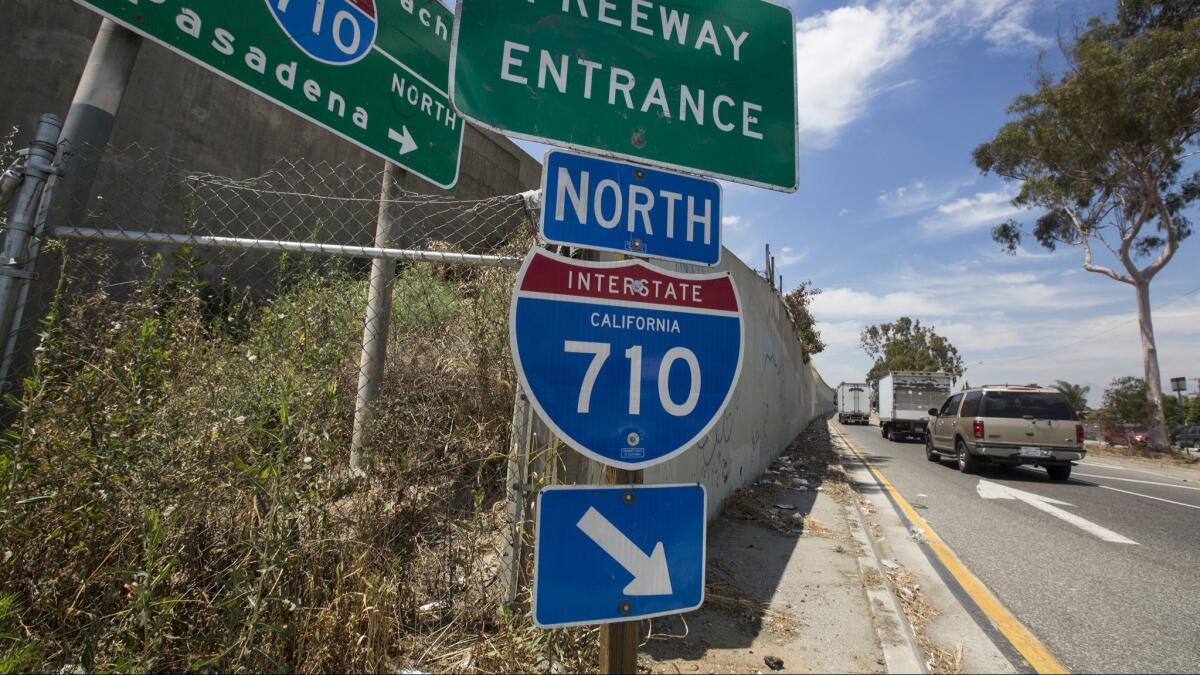Caltrans effectively kills 710 Freeway extension after decades-long battle

- Share via
California transportation officials effectively ended a six-decade battle over the unfinished 710 Freeway this week, recommending against a costly, controversial freeway tunnel that would have been the longest in the state.
Caltrans’ decision to prioritize a series of street improvements over an extension of the freeway comes a year after the Metropolitan Transportation Authority stripped the 710 tunnel of about $700 million in funding and dedicated the funds to freeway, interchange and surface street improvements.
Local officials, including Pasadena Mayor Terry Tornek, cheered the decision, calling it a “historic day” decades in the making. State Sen. Anthony Portantino (D-La Cañada Flintridge) said the decision would eliminate “the threat of the freeway.”
Timeline: The epic and ugly battle over what to do about the 710 Freeway »
In the heyday of Los Angeles County freeway construction, engineers dreamed of a north-south route through the San Gabriel Valley that would allow seamless movement between the ports and Pasadena.
But vehement opposition from preservation activists in Pasadena and South Pasadena put the project on hold for decades, to the chagrin of cities near the 710’s abrupt terminus in Alhambra, where heavy freight traffic spills onto local streets.
Bringing back the tunnel would require a new environmental analysis, said Caltrans spokeswoman Lauren Wonder. The most recent set of environmental documents has been in the works for nearly a decade.
Portantino told The Times he will introduce a bill in Sacramento next week that would delete references in state law to the 710 Freeway between the 210 and Valley Boulevard, its current end point.
“The project will cease to exist, once deleted,” he said in an email.
Opponents spent decades fighting the freeway project in court. In 2003, federal officials rescinded their approval of the freeway extension, saying so much time had passed since the environmental review was approved in 1992 that Caltrans would have to start over.
A decade ago, the extension found new life when Los Angeles County voters approved a half-cent sales tax increase that allocated $780 million in funding for the 710 corridor.
Metro and Caltrans later recommended four options for closing the gap, including a light-rail line, a bus rapid-transit route or a variety of freeway tunnel options, including twin-bore tunnels between Pasadena and Alhambra with a price tag of $5.2 billion.
Portantino’s bill will also “clarify the value” of some of the hundreds of homes and apartment buildings in the path of the freeway, he said. In the 1950s, the agency began buying empty lots, houses and apartments along the planned route of extension, expecting to tear them down.
Three years ago, when transportation officials decided that any option to close the gap would be built underground, Caltrans began preparing the homes for sale.
Under a state law passed in 1979, current low-income renters in the Caltrans homes will receive a sale price below the market rate, as will tenants who make less than 150% of the county’s median income.
The next potential buyers would be affordable housing development companies, then current tenants above the income thresholds who can pay the market rate, then former tenants in reverse order of occupancy. After that, the properties would be sold at public auction.
Portantino said in an email that the bill would “clarify the value of the Caltrans properties operated by long-standing nonprofits so they can purchase their properties according to their use in a fair and responsible manner.”
Cormaci writes for Times Community News.
UPDATES:
5:05 p.m.: This article was updated with additional reporting and background.
This article was originally published at 7:35 a.m.
More to Read
Sign up for Essential California
The most important California stories and recommendations in your inbox every morning.
You may occasionally receive promotional content from the Los Angeles Times.












